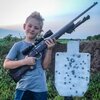on a man sized target it’s not as bad. but on a real man you’re still trying to hit a vital area not just scrape the edge.Thanks all.
Mu concern was at 500, the lack of wind flags or a spotter in the field would make hitting a stationary man sized silhouette at that distance as I have heard the small light 5.56 bullet gets blown all over the place.
Obviously this seems to not be the case from most members actual reports and experiences.
the best way to understand this is to look up WEZ analysis. Bryan litz wrote a lot about it and made a calculator. You can Google it and see how it works. Basically it simulates a large number of shots and then does some statistical analysis to see how the probability of a hit changes as the wind or target size or bullet and velocity change.
if you do this analysis on a mil spec bullet compared to say a match 6mm, you’ll see an enormous difference in how much the wind moves them around.
But at only 500 yards on such a huge target it doesn’t matter that much



